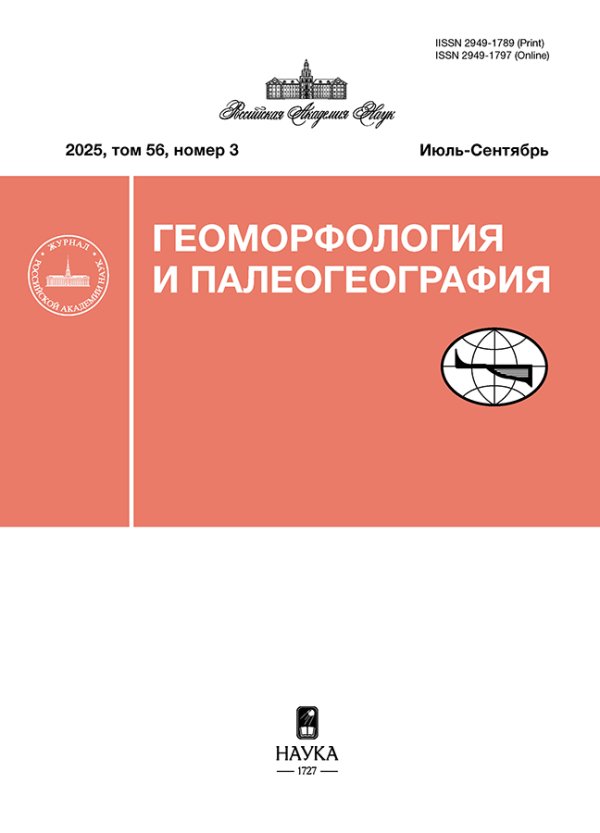ENVIRONMENT DEVELOPMENT AND THE EVOLUTION OF GNILOE LAKE (SOUTH-EASTERN PRIMORYE) DURING THE LAST 3300 YEARS1
- Authors: Lyashchevskaya M.S.1, Bazarova V.B.1, Makarova T.R.1
-
Affiliations:
- Pacific Geographical Institute of the Far Eastern Branch of RAS
- Issue: Vol 54, No 3 (2023)
- Pages: 108-123
- Section: SHORT COMMUNICATIONS
- URL: https://journals.rcsi.science/2949-1789/article/view/140586
- DOI: https://doi.org/10.31857/S2949178923030064
- EDN: https://elibrary.ru/WDCBGO
- ID: 140586
Cite item
Full Text
Abstract
A continuous record of paleogeographic events in south-eastern Primorye has been reconstructed based on the deposits of Gniloe Lake. The lake is located on the northern coast of Nakhodka Bay. Starting from 3240 cal. BP. 5 warming periods were identified: 3240–2500, 1865–1653, 1330–838, 733–624 cal. BP and from the second half of the 17th century to the present; 4 periods of cooling: 2500–1865, 1653–1330, 838–733 and 624–322 cal. BP; 6 wet periods: 3240–2500, 1865–1653, 1479–1330, 1056–838, 733–624 cal. BP and last 280 years; 5 dry periods: 2500–1865, 1653–1479, 1330–1056, 838–733 and 624–210 cal. BP. According to palynological analysis, the expansion of Pinus koraiensis and dark coniferous species occurred during the second phase of the Mid-Subatlantic cooling of 1479–1330 cal. BP. In the last 150 years, the most significant changes have been associated with the anthropogenic transformation of landscapes as a result of urbanization. The area of forests and their species composition have decreased. At present, shrubs have occupied areas of the deforested oak forests. Based on the results of diatom analysis, 7 stages of the development of Gniloe Lake were identified. There was a shallow semi-open lagoon at a sea level 1–1.5 m higher than the present day about 3240 cal. BP. Cooling and decrease in humidity about 2500 cal. BP led to the formation of a slightly saline semi-enclosed lagoon. Shallowing of the lagoon about 2000 cal. BP was due to a decrease in sea level. Finally, the lagoon separated from the sea about 1450 cal. BP. The transformation of the lagoon into a fresh lake occurred around 1080 cal. BP. During the period of cooling 840–733 cal. BP the shallowing of the lake began, which continued in the Little Ice Age. The increase of the lake level associated with moderate warming and an increase in humidity began at 210 cal. BP. Traces of three catastrophic events were recorded in the sediments of Gniloe Lake – a high-intensity storm about 3000 cal. BP and 2 tsunamis around 2000 and 1560 cal. BP.
About the authors
M. S. Lyashchevskaya
Pacific Geographical Institute of the Far Eastern Branch of RAS
Author for correspondence.
Email: lyshevskay@mail.ru
Russia, Vladivostok
V. B. Bazarova
Pacific Geographical Institute of the Far Eastern Branch of RAS
Author for correspondence.
Email: bazarova@tigdvo.ru
Russia, Vladivostok
T. R. Makarova
Pacific Geographical Institute of the Far Eastern Branch of RAS
Author for correspondence.
Email: mctatiana@mail.ru
Russia, Vladivostok
References
- Barinova S.S., Medvedeva L.A., Anissimova O.V. (2006). Bioraznoobrazie vodoroslei – indikatorov okruzhayushchei sredy (Diversity of algal indicators in environmental assessment). Tel Aviv: Pilies Studio (Publ.). 498 p. (in Russ.)
- Bazarova V.B., Grebennikova T.A., Orlova L.A. (2014). Natural-environment dynamics within the Amur basin during the Neoglacial. Geography and Natural Resources. Vol. 35. P. 275–283. https://doi.org/10.1134/S1875372814030111
- Bazarova V.B., Lyashchevskaya M.S., Makarova T.R., Orlova L.A. (2018). Sedimentation conditions on floodplains of rivers of the Khanka Plain (southern Far East) in the middle–late Holocene. Russian Journal of Pacific Geology. Vol. 12. No. 6. P. 593–603. https://doi.org/10.1134/S1819714018060106
- Blaauw M., Christen J.A. (2011). Flexible paleoclimate age-depth models using an autoregressive gamma process. Bayesian Analysis. Vol. 6. No. 3. P. 457–474. https://doi.org/10.1214/11-BA618
- Chu K. (1973). A Preliminary Study on the Climate Fluctuations during the Last 5000 Years in China. Scientia Sinica. Vol. 16. P. 226–256.
- Duan V., Pu Q., Wu X. (1981). A preliminary study оf Quaternary climatic changes in China. Selected papers of the conference 1978 on climatic changes in China. Beijing: Central Meteorological Agency. P. 7–17.
- Ganzei L.A., Razjigaeva N.G., Nishimura Yu. et al. (2015). Historical and paleotsunami deposits of the Eastern Primorye coast. Tikhookeanskaya geologiya. Vol. 34. No. 1. 80–96. (in Russ.)
- Ganzey L.A., Razzhigaeva N.G., Arslanov K.A. et al. (2018). Manifestation of paleotsunami on the coast of Primorye in the Holocene. Geomorfologiya. No. 2. P. 20–31. (in Russ.) https://doi.org/10.7868/S0435428118020025
- Ganzey L.A., Razzhigaeva N.G., Nishimura Yu. et al. (2016). Manifestation of Late Holocene paleotsunami on Triozer’e Bay coast, Sea of Japan. Uspekhi sovremennogo estestvoznaniya. No. 8. P. 166–172. (in Russ.)
- Grimm E. (2004). Tilia software 2.0.2. Springfield: Illinois State Museum Research and Collection Center.
- Helama S., Jones P.D., Briffa K.R. (2017). Dark Ages Cold Period: A literature review and directions for future research. The Holocene. Vol. 27. No. 10. P. 1600–1606. https://doi.org/10.1177/09596836176938
- Kharitonov V.G. (2010). Konspekt flory diatomovykh vodoroslei (Bacillariophyceae) Severnogo Okhotomor’ya (Summary of diatom (Bacillariophyceae) flora of the northern coast of the Sea of Okhotsk). Magadan: SVNTs DVO RAN (Publ.). 189 p. (in Russ.)
- Khershberg L.B., Mikhailik E.V., Pushkar V.S., Vachaev B.I. (2013). Structure, the physical composition of shelf on south Primorye and prospects for its development. Tikhookeanskaya geologiya. Vol. 32. No. 2. P. 90–99. (in Russ.)
- Khotinsky N.A. (1977). Golotsen Severnoi Evrazii (Holocene of the Northern Eurasia). Moscow: Nauka (Publ.). 192 p. (in Russ.)
- Klimenko V.V., Klimanov V.A., Kozharinov A.V. (2000). Dynamics of the vegetation and climate of Amur-Zeya interstream area in Holocene and the forecast of their natural changes. Izvestiya RAN. Seriya geografiche-skaya. No. 2. P. 42–50. (in Russ.)
- Kobysheva N.V. (Ed.). (1988). Nauchno-prikladnoi spravochnik po klimatu SSSR. Seriya 3. Mnogoletnie dannye. Ch. 1–6. Vyp. 26. Primorskii krai (Scientific and applied reference book on the climate of the USSR. Series 3. Long-term data. Parts 1–6. Issue 26. Primorsky Kraii). Leningrad: Gidrometeoizdat (Publ.). 416 p. (in Russ.)
- Korotkii A.M., Anderson P.M., Lozhkin A.V. et al. (2004). Development of landscapes in Southeastern Primor’ye during the Middle and Late Holocene. Prostranstvenno-vremennaya izmenchivost' prirodnoi sredy Severo-Vostochnoi Azii v chetvertichnyi period. Magadan: SVKNII DVO RAN (Publ.). P. 12–50. (in Russ.)
- Korotky A.M., Karaulova L.P., Troitskaya T.S. (1980). Chetvertichnye otlozheniya Primor’ya (The Quaternary deposits of Primor’ye). Novosibirsk: Nauka (Publ.). 234 p. (in Russ.)
- Korotky A.M., Volkov V.G., Grebennikova T.A. et al. (1999). Far East. Izmenenie klimata i landshaftov za poslednie 65 mln let. Moscow: GEOS (Publ.). P. 146–164. (in Russ.)
- Krammer K. (2000). Diatoms of Europe. Vol. 1: The Genus Pinnularia. Königstein: A.R.G. Gantner Verlag. Kommanditgesellschaft (Publ.). 703 p.
- Krammer K., Lange-Bertalot H. (1986). Bacillariophyceae. 1. Teil. Naviculaceae. Subwasserflora von Mitteleuropa Bd. 2. Stuttgart: Pascher. Gustav Fisher Verlag (Publ.). 876 p.
- Krammer K., Lange-Bertalot H. (1991). Bacillariophyceae. 3. Teil: Centrales, Fragilariaceae, Eunotiaceae. Süsswasserflora von Mitteleuropa. Stuttgart: Gustav Fisher Verlag (Publ.). 576 p.
- Lyashchevskaya M.S., Pshenichnikova N.F., Makarova T.R. (2017). Reaction of vegetation to climatic changes in Middle-Late Holocene (at the example of a coast site in South-East Primorye). Uspekhi sovremennogo estestvoznaniya. No. 12. P. 184–194. (in Russ.)
- Maejima I., Tagami Y. (1983). Climate of Little Ice Age in Japan. Geographical Reports of Tokyo Metropolitan University. Vol. 18. P. 91–111.
- Mikishin Yu.A., Gvozdeva I.G. (2014). Paleoenvironment of Russian Island (southern Primorye) in middle-late Holocene. Fundamental’nye issledovaniya. Vol. 3. No. 3. P. 516–522. (in Russ.)
- Mikishin Yu.A., Petrenko T.I., Popov A.N., Orlova L.A. (2007). Paleogeography of Khanka Lake in Late Holocene. Nauchnoe obozrenie. No. 2. P. 7–13. (in Russ.)
- Novenko E.Yu. (2020). Landscape and climatic changes in the forest zone of Central and Eastern Europe in the Holocene: a retrospective analysis and scenarios for the evolution of the natural environment. Ekosistemy: ekologiya i dinamika. Vol. 4. No. 4. P. 57–80. (in Russ.) https://doi.org/10.24411/2542-2006-2020-10074
- Ogilvie A.E.J. (1991). Climatic changes in Iceland A.D. c. 865 to 1598. Acta Archaeolog-Den. Vol. 61. P. 233–251.
- Pokrovskaya I.M. (Ed.). (1950). Pyl’tsevoi analiz (Pollen analysis). Moscow: Gos. izd-vo geol. lit-ry (Publ.). 571 p. (in Russ.)
- Polyakova E.I. (1979). Diatomic algae in recent deposits of the Chukchi Sea Coast and their paleogeographical meaning. Izvestiya AN SSSR. Seriya geograficheskaya. No. 4. P. 90–94. (in Russ.)
- Prokopenko S.V. (2014). Vascular flora of the Trudnyi Peninsula (Nakhodka City and its vicinity). Komarovskie chteniya. No. 62. P. 106–228. (in Russ.)
- Proshkina-Lavrenko A.V. (Ed.). (1974). Diatomovye vodorosli SSSR (iskopaemye i sovremennye) T. 1. (The diatoms of the USSR (fossil and recent) Vol. 1). Leningrad: Nauka (Publ.). 403 p. (in Russ.)
- Razjigaeva N.G., Ganzey L.A., Bazarova V.B. et al. (2019). Landscape response to the Medieval Warm Period in the South Russian Far East. Quaternary International. Vol. 519. P. 215–231. https://doi.org/10.1016/j.quaint.2018.12.006
- Razjigaeva N.G., Ganzey L.A., Grebennikova T.A. et al. (2020a). Reconstruction of Late Holocene extreme hydrological events of the Valentin Bay coast, the Sea of Japan. Russian Journal of Pacific Geology. Vol. 14. No. 2. P. 180–192. https://doi.org/10.1134/S1819714020020086
- Razjigaeva N.G., Ganzey L.A., Grebbennikova T.A. et al. (2016). Changes of the coastal and the mountains surrounding Kit Bay landscapes (Primorye) in the Middle and Late Holocene. Geografiya i prirodnye resursy. No. 3. P. 141–151. https://doi.org/10.21782/GiPR0206-1619-2016-3(141-151)
- Razjigaeva N.G., Ganzey L.A., Grebbennikova T.A. et al. (2018). Landscape and environmental changes along the Eastern Primorye coast during the middle to late Holocene and human effects. Journal of Asian Earth Sciences. Vol. 158. P. 160–172. https://doi.org/10.1016/j.jseaes.2018.02.013
- Razzhigaeva N.G., Ganzey L.A., Grebbennikova T.A. et al. (2020b). Interaction of Natural and Anthropogenic Factors in Landscape Development of Razdolnaya River Basin, Primorye. Izvestiya RAN. Seriya geograficheskaya. Vol. 84. No. 2. P. 246–258. (in Russ.) https://doi.org/10.31857/S2587556620020119
- Sakaguchi Y. (1983). Warm and cold stages in the past 7600 years in Japan and their global correlation. Bull. Dept. Geogr. Univ. Tokyo. Vol. 15. P. 1–31.
- Sakaguchi Y. (1989). Some pollen records from Hokkaido and Sakhalin. Bull. Dept. Geogr. Univ. Tokyo. Vol. 21. P. 1–17.
- Van Dam H., Mertens A., Sinkeldam J. (1994). A coded checklist and ecological indicator values of freshwater diatoms from The Netherlands. Netherlands Journal of Aquatic Ecology. Vol. 28. P. 117–133. https://doi.org/10.1007/BF02334251
- Vlasov S.А. (2008). Zhilishchnoe stroitel’stvo na Dal’nem Vostoke (1946–1991 gg.) (Housing construction in the Far East (1946–1991). Vladivostok: Dal’nauka (Publ.). 204 p. (in Russ.)
- Wilson R., Anchukaitis K., Briffa K.R. et al. (2016). Last millennium northern hemishere summer temperatures from tree rings: Part I: The long term context. Quaternary Science Reviews. Vol. 134. P. 1–18. https://doi.org/10.1016/j.quascirev.2015.12.005
Supplementary files















